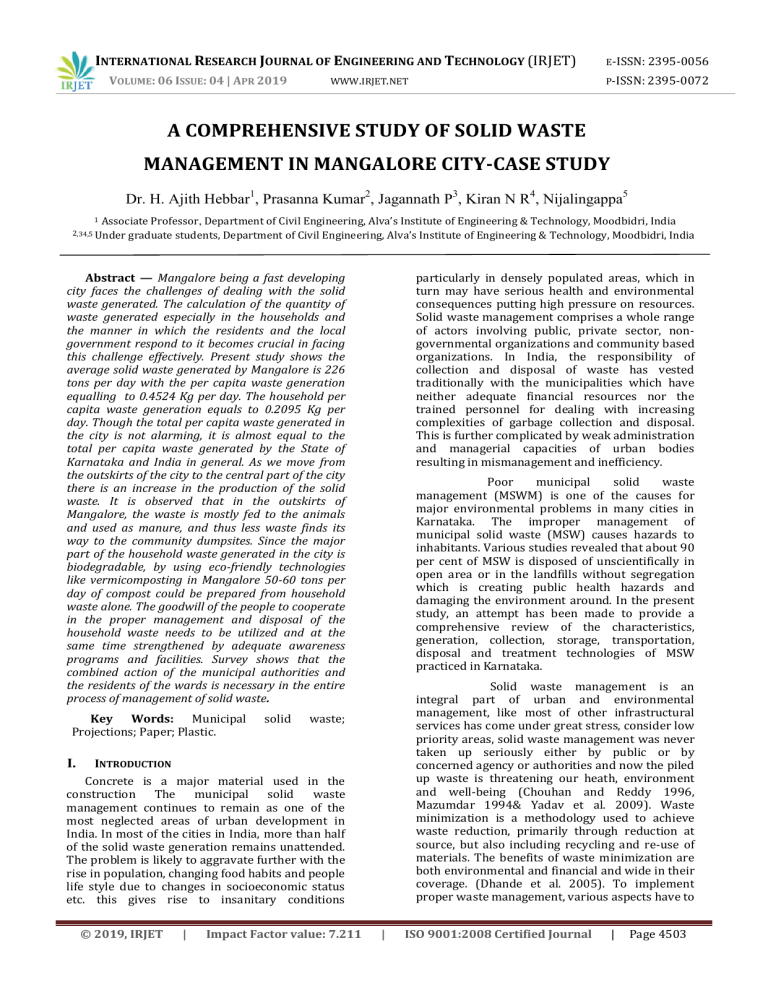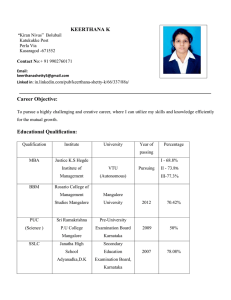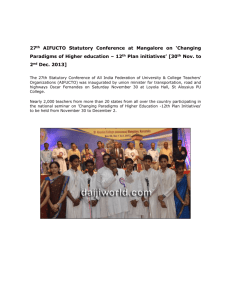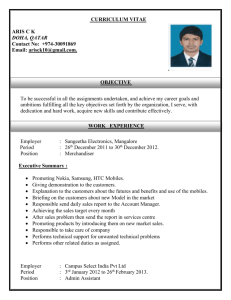Uploaded by
International Research Journal of Engineering and Technology (IRJET)
Solid Waste Management in Mangalore: A Case Study
advertisement

INTERNATIONAL RESEARCH JOURNAL OF ENGINEERING AND TECHNOLOGY (IRJET) VOLUME: 06 ISSUE: 04 | APR 2019 WWW.IRJET.NET E-ISSN: 2395-0056 P-ISSN: 2395-0072 A COMPREHENSIVE STUDY OF SOLID WASTE MANAGEMENT IN MANGALORE CITY-CASE STUDY Dr. H. Ajith Hebbar1, Prasanna Kumar2, Jagannath P3, Kiran N R4, Nijalingappa5 1 Associate Professor, Department of Civil Engineering, Alva’s Institute of Engineering & Technology, Moodbidri, India graduate students, Department of Civil Engineering, Alva’s Institute of Engineering & Technology, Moodbidri, India 2,34,5 Under Abstract — Mangalore being a fast developing city faces the challenges of dealing with the solid waste generated. The calculation of the quantity of waste generated especially in the households and the manner in which the residents and the local government respond to it becomes crucial in facing this challenge effectively. Present study shows the average solid waste generated by Mangalore is 226 tons per day with the per capita waste generation equalling to 0.4524 Kg per day. The household per capita waste generation equals to 0.2095 Kg per day. Though the total per capita waste generated in the city is not alarming, it is almost equal to the total per capita waste generated by the State of Karnataka and India in general. As we move from the outskirts of the city to the central part of the city there is an increase in the production of the solid waste. It is observed that in the outskirts of Mangalore, the waste is mostly fed to the animals and used as manure, and thus less waste finds its way to the community dumpsites. Since the major part of the household waste generated in the city is biodegradable, by using eco-friendly technologies like vermicomposting in Mangalore 50-60 tons per day of compost could be prepared from household waste alone. The goodwill of the people to cooperate in the proper management and disposal of the household waste needs to be utilized and at the same time strengthened by adequate awareness programs and facilities. Survey shows that the combined action of the municipal authorities and the residents of the wards is necessary in the entire process of management of solid waste. Key Words: Municipal Projections; Paper; Plastic. I. solid particularly in densely populated areas, which in turn may have serious health and environmental consequences putting high pressure on resources. Solid waste management comprises a whole range of actors involving public, private sector, nongovernmental organizations and community based organizations. In India, the responsibility of collection and disposal of waste has vested traditionally with the municipalities which have neither adequate financial resources nor the trained personnel for dealing with increasing complexities of garbage collection and disposal. This is further complicated by weak administration and managerial capacities of urban bodies resulting in mismanagement and inefficiency. Poor municipal solid waste management (MSWM) is one of the causes for major environmental problems in many cities in Karnataka. The improper management of municipal solid waste (MSW) causes hazards to inhabitants. Various studies revealed that about 90 per cent of MSW is disposed of unscientifically in open area or in the landfills without segregation which is creating public health hazards and damaging the environment around. In the present study, an attempt has been made to provide a comprehensive review of the characteristics, generation, collection, storage, transportation, disposal and treatment technologies of MSW practiced in Karnataka. Solid waste management is an integral part of urban and environmental management, like most of other infrastructural services has come under great stress, consider low priority areas, solid waste management was never taken up seriously either by public or by concerned agency or authorities and now the piled up waste is threatening our heath, environment and well-being (Chouhan and Reddy 1996, Mazumdar 1994& Yadav et al. 2009). Waste minimization is a methodology used to achieve waste reduction, primarily through reduction at source, but also including recycling and re-use of materials. The benefits of waste minimization are both environmental and financial and wide in their coverage. (Dhande et al. 2005). To implement proper waste management, various aspects have to waste; INTRODUCTION Concrete is a major material used in the construction The municipal solid waste management continues to remain as one of the most neglected areas of urban development in India. In most of the cities in India, more than half of the solid waste generation remains unattended. The problem is likely to aggravate further with the rise in population, changing food habits and people life style due to changes in socioeconomic status etc. this gives rise to insanitary conditions © 2019, IRJET | Impact Factor value: 7.211 | ISO 9001:2008 Certified Journal | Page 4503 INTERNATIONAL RESEARCH JOURNAL OF ENGINEERING AND TECHNOLOGY (IRJET) VOLUME: 06 ISSUE: 04 | APR 2019 E-ISSN: 2395-0056 WWW.IRJET.NET be considered such Source reduction, Onsite storage, Collection & transfer, Processing, and Disposal (Rajput et al. 2009). Solid waste may be defined as generation of undesirable substances which is left after they are used once. They cannot be reused directly by the society for its welfare because some of them may be hazardous for human health. Covering of various vegetables, fruits and cooked material facilitate proliferation of various group of microbial flora, which may be pathogens. (Shivashankara et al. 2005 & Macwan 2003)There are many categories of Solid Waste such as food waste, rubbish, commercial waste, institutional waste, street sweeping waste, industrial waste, construction and demolition waste, and sanitation waste. P-ISSN: 2395-0072 Table 1: solid waste management in Mangalore City Corporation (as per 2018) Name of the City/Town and State Population Area in sq. kilometres Name & Address of the local body. Telephone No. Fax No. E-mail: Name and address of operator of the facility Solid Waste contains recyclables (paper, plastic, glass, metals, etc.), toxic substances (paints, pesticides, used batteries, medicines), compostable organic matter (fruit and vegetable peels, food waste) and soiled waste (blood stained cotton, sanitary napkins, disposable syringes) (Jha et al., 2003, Reddy & Galab, 1998, and Khan, 1994). The quantity of Solid Waste generated depends on a number of factors such as food habits, standard of living, degree of commercial activities and seasons. Data on quantity variation and generation are useful in planning for collection and disposal systems. In India the different state generated huge amount of waste in different amount, per capita waste generated in different state of India given by CPCB in 2000 under status of MSW generation, collection, treatment, and disposal vary from 0.157 kg per capita per day. Name of officer incharge of the facility Phone No: Fax No: Email: Number of households in the city/town, Number of non-residential premises in the city Number of election/ administrative wards in the city/town Estimated Quantity of solid waste generated in the local body area per day in metric tones II PRESENT STUDY Present study is focused on the solid waste management in Mangalore city, Dakshina kannada district. Various aspects of solid waste management such as generation, collection, transportation, disposal, treatment and landfill etc,. will be collected by making a field visit and data collection from concerned authorities. Mangalore 489488(as on 2011 census) 547000 (as on 2017 approx.) 132.45 sq.km Mangalore City Corporation Lalbagh, MG Road, Mangalore +91-824-2220313/18 +91-824-2220310 commissioner.mcc@gmail.com M/s Unique Waste Processing Company Ltd., SWM Processing Site, Pachanady, Vamunjoor, Mangalore Sri.Vamshi Sheelam,Project In charge, M/s Unique +91-7259394477, +91-9701220077 vamshi.sheelam@ilfsindia.com Dr. A. Manjayya Shetty Health Officer, Mangalore City Corporation +91-824-2220310 healthofficer.mlr@gmail.com +91-9480871857 112000 No’s 29100 No’s 60 No’s 300 tpd The major components of management are; solid waste Segregation at the source Primary (Door to Door) Collection Secondary Storage Transportation Treatment and Processing Disposal III Segregation: While 50% of the households separated the recyclable items like metals and hardboards and plastics, 40% did not separate even the recyclables. 46.25% separated the compostable waste and used it as manure for the garden. About the separation of other waste like food, plastic, paper, glass etc they Fig, 1 shows the study area. © 2019, IRJET | Impact Factor value: 7.211 | ISO 9001:2008 Certified Journal | Page 4504 INTERNATIONAL RESEARCH JOURNAL OF ENGINEERING AND TECHNOLOGY (IRJET) VOLUME: 06 ISSUE: 04 | APR 2019 WWW.IRJET.NET are of the opinion that since all the waste is dumped together there is no value in keeping it separate. However, if they are asked to do so by the MCC for its separate collection, 76.25% were willing to separate the recyclable waste and 81.25% were willing to separate the compostable waste. The separation of waste, especially of the biodegradable waste is very important for their treatment since the different materials have different biochemical composition. This will help in choosing proper treatment method such as vermicomposting (Fig 4.1 shows Segregation of wet waste and dry waste in Mangalore) At source level, individuals are expected to maintain two dust bins one for wet and another for dry waste. The hazardous waste can be stored in cover. It should be given to the collection vehicle, It is the responsibility of every individual to store the waste generated by them separately and deliver the same to the collection vehicles. At community level, it is proposed to have container system, which can be carried off to disposal site with the help of secondary transportation vehicles. Secondary storage points can be classified based on the type of area. Each storage location will have one container for wet waste. These containers are placed on a P.C.C platform with proper drainage facility, to avoid any leachate seepages. PCC slab and containers are designed as per the standard specifications provided by DMA. Collection vehicle will tip the waste into respective containers placed in that area. Segregation of wastes into wet, dry/ recyclables and household hazardous waste. Familiarizing people about the solid waste management system adopted. Training program for retrievers regarding importance of segregation, proper handling of waste and its hazards due to improper handling IV Primary collection: As per the collection of waste is concerned though in Shivbhag and Falnir wards there is door to door collection, only 32.5% participate in it. The collection here is done by private parties against certain fixed amount. Rest all manage their waste by themselves by dumping it at the nearby communal disposal sites. 42.5% of the households get rid of their waste daily, where as others get rid of it twice a week, now and then or on weekly basis. As far as handling of the waste is concerned 81.25% percent of the families parents or relatives handled the waste and only 18.75% children were involved in handling the waste. More than 90% of the people said that they are not given any coloured containers for the separation of wastes by the MCC though they are aware through the media that such a practice exists. P-ISSN: 2395-0072 V Secondary storage: In the Secondary collection action plan Waste is stored at two levels Source level and Community level. Door to door waste collection system is being carried out in 60% of the Mangalore City Corporation Limits Programmatic street sweeping. MSW is not being mixed with hospital and industrial waste No Burning of waste House owners being levied fine for throwing the garbage in open space. Conducting awareness campaigns for schools, colleges, Institutes and for citizens. Primary door to door collection is been outsourced with the regular sanitation works. | Impact Factor value: 7.211 Closed metal secondary storage containers are being provided. Manual handling of waste is being minimized. VI Treatment & processing: Windrow composting and Vermicomposting is provided under KUDCEMP Program at a cost of 6.48 cores. Provision of 145 TPD of waste is aerobically composted through Windrow method and 25 TPD of waste is vermin composted. Rejects from Compost plant will be transported to sanitary landfill site. Mangalore City Corporation is handling the operation and maintenance of compost plant since 2008. Operation of Vermi-composting is started since 2010. VII Disposal / land filling: As per MSW Rules 2000, guidelines and specifications for development and operation of landfill site is clearly mentioned. Only inert wastes are proposed for disposal in the landfill site Disposal ways: Wet Waste: Pachanady Sanitary landfill Site - (to & fro 24 Km distance from MCC). Dry Waste: Pachanady Sanitary landfill Site (to & fro 24 Km distance from MCC). Near Pachanady. © 2019, IRJET E-ISSN: 2395-0056 | Development of the landfill would be done ISO 9001:2008 Certified Journal | Page 4505 INTERNATIONAL RESEARCH JOURNAL OF ENGINEERING AND TECHNOLOGY (IRJET) VOLUME: 06 ISSUE: 04 | APR 2019 WWW.IRJET.NET VIII Decentralized treatment method To reduce the burden on the centralized processing plant and sanitary landfill site, MCC started with a pilot project on converting waste to energy i.e., BioMethanation Plant. (Fig 4.7) Bhaba Atomic Research Centre Technology was selected for decentralization system. Urwa market was selected for the construction and implementation of Biometh nation plant. 2 Tons per day capacity plant was designed and was tendered to M/s Wipro Eco Energy for construction & Installation at a cost of 25 lakhs and followed by 2 years of Operation and Maintenance of the plant. The plant is generating 150-160 m3/day of gas and 100 -120 Kg/day of Manure. It is also proposed to utilize the gas for generating power & illuminate the market surrounding. Satellite image of landfill site and processing site at Vamanjoor is shown in Figures 4.9, 4.10 and 4.11. X Awards & Achievements Mangalore city corporation got following reorganization in solid waste management. 1. In 2009 Jadavpur University, Kolkata Awarded ICON SWM Award for Mangalore City as the Second Best City under Solid Waste Management. 2. Union Ministry of Urban Development Awarded Mangalore City Corporation 8th Cleanest City in May 2010. 3. Green Leaf Award was awarded at Hyderabad by Suzuki Exnora to Mangalore City Corporation for Solid Waste Management. 4. In 2011 Jadavpur University, Kolkata Awarded ICON SWM Award Mangalore City as the First Best City under Solid Waste Management. XI CONCLUSIONS AND FUTURE SCOPE IX Problems associated with Mechanisms of SWMS In recent years in India, most of the urban local bodies have been experiencing huge expenditure on solid waste disposal with very poor efficiency, pollution due to the burning of waste, unorganized and poorly co-coordinated transportation resulting in excessive fuel usage and pollution generation, loss of reusable/recyclable material due to un segregated collection, unhygienic condition leading to public health problem and spread of disease to local as well as global air pollution due to the uncollected and poorly disposed waste, dirty streets and cities failing to attract foreign investments and markets, etc. In the light of these problems, the mechanisms and managing the urban solid wastes have gaining importance; and various methods at different stages have been tried in recent years. However the development of infrastructure facilities and disposal methods has not kept pace with the rate of waste generation, leading to increased pollution and environmental impacts. The increase in the growth of the solid wastes and failure to manage it | Impact Factor value: 7.211 P-ISSN: 2395-0072 sustainable, worsened and act as a major bottleneck for development in particular in a growing densely populated city like Mangalore. Waste generated by households, commercial establishments and the industry is discharged into street bins and only a few households have door-to-door collection services through the informal or formal sector. In fact, the garbage in bins usually ends up scattered over pavements and roads. Although municipal trucks collect the garbage and finally drop it at disposal sites, large number of rag pickers sort out the garbage and the material type sorts out retrieve valuable material. Sometimes cleaned and then solid to waste dealers or wholesalers who latter supply it to other industries leading to generation of incomes to the people involved. in 4 phases. Phase I for 6 years’ time frame, phase II, III and IV for 3 years, 6 years and for 10 years’ time frame consecutively. Landfill Site is operational since 2010. Rejects from the compost plant will be land filled. Daily soil top cover of 30 cm will be provided. © 2019, IRJET E-ISSN: 2395-0056 Following conclusion drawn after making a thorough study on SWM | The selected site at Pachanady, Vamunjoor, Mangalore measures about 132.45 sq. kms and for a population of 547000 the selected site is adequate for the treatment and disposal of solid waste generated in Mangalore city. But present method of landfilling unscientific and better methods must be suggested to the concerned authorities. It is found that with increase in the global population and the rising demand for food and other essential, there has been a rise in the amount of waste being generated daily by each household waste that is not properly managed, eccentrically excreta and other liquid solid waste from household and the community, are a serious health hazard and lead to the speed of infectious diseases. ISO 9001:2008 Certified Journal | Page 4506 INTERNATIONAL RESEARCH JOURNAL OF ENGINEERING AND TECHNOLOGY (IRJET) VOLUME: 06 ISSUE: 04 | APR 2019 WWW.IRJET.NET E-ISSN: 2395-0056 P-ISSN: 2395-0072 [9] Dr. R K Pandith-3, March 2013 - Problems of Solid Waste Management in Indian Cities (IJIRST) Vol 03, 03 March 2013. Plastic wastes are segregated and sent for recycling. The Mangalore city corporation received ‘India’s best city in solid waste management award under the categories of cities having a population between three lakh and 10 lakh under Swachh Survekshan 2018 at Indore, Madhya Pradesh. Mangalore city Management system has very good waste transportation and Segregation system. Due to improper disposal of the solid waste in the landfill site an odour nuisance prevails in Vamanjoor area, which needs to be seriously addressed. The cooperation from the public is quite significant hence the public must be made aware of minimization of solid waste and segregation at the source [10] Jil Tushar Sheth-03, February 2016 - Solid Waste Management: A Case Study of Ahmedabad (IJSRD) Vol 01, 03 February 2016. [15] S.Soundharya, Dr.K.Nirmalkumar “Study on the Effect of Calcite-Precipitating Bacteria on Self-Healing Mechanism of Concrete (Review Paper)” July- 2014 Volume 1, Issue-4. [16] Shubham Abhayanath Thakur, Sudesh Atmaram Thombare, Tanvir Liyamuhammed Kadvekar “Bacterial Concrete: A Review” ISSN 2394 – 3386 Volume 5, Issue 2 February 2018. [17] .Dr. S.Krishnapriya, G.Mathan kumar, S.Sanjay raj , S.Manoj kumar , M.Vinothkumar “Cost Reduction in Bacterial Concrete by using Poultry Feed as an Alternate Substrate” Special Issue ICRTECITA April 2018. XII REFRENCES [1] Vipin Upadhyay-3, March 2012- Solid Waste Collection and Segregation. International Journal of Engineering and Innovative Technology (IJEIT) Volume 1, Issue 3, March 2012. [2] Rajendra Kumar Kaushal- 04 April 2012Municipal Solid Waste Management in IndiaInternational Journal of Engineering Science and Technology (IJEST) Vol. 4 No.04 April 2012. [3]A Ahsan-27, March 2014 - Assessment of Municipal Solid Waste Management System in a Developing Country, Vol. 1, March 2014. [4] Mohd Arshad Siddiqqui- 01, January 2018 Municipal solid waste management in India-Status and Challenges: An overview (IJOBR) Vol.03, 01, January 2018. [5] M S Kadam-11, March 2016 - Study and Analysis of Solid Waste Management Challenges and Options for Treatment (Indian Villages) (IOSRJMCE) Vol. 01, 11 March 2016. [6] B L Chavan-2, December 2013 - A Case Study on Municipal Solid Waste Management in Solapur City, Maharashtra, India (IJEIT) Vol 01, December 2013. [7] Odile Schwarz Herion-03, January 2008- A case study on successful municipal solid waste management in industrialized countries (IJEIT) Vol 03, January 2008. [8] Neeraj Kumar Patel-02, July 2016Opportunity and Challenges of Municipal Waste Disposal in India (IJIRST) Vol 03, 02 July 2016. © 2019, IRJET | Impact Factor value: 7.211 | ISO 9001:2008 Certified Journal | Page 4507



